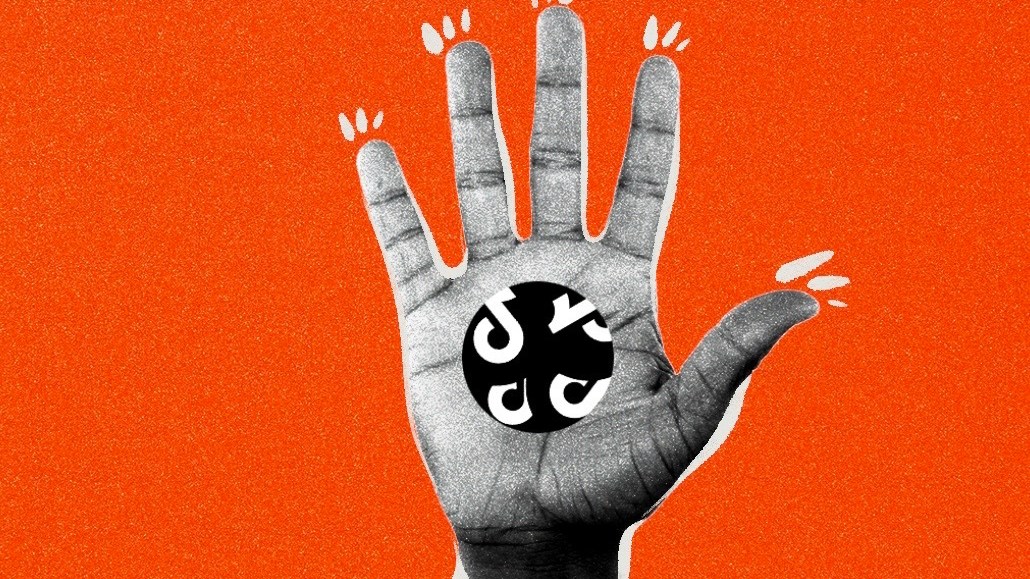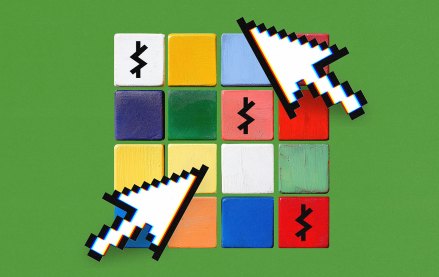Media Buying Briefing: Agencies debate biggest questions over TikTok’s future

This Media Buying Briefing covers the latest in agency news and media buying for Digiday+ members and is distributed over email every Monday at 10 a.m. ET. More from the series →
While TikTok’s future in the U.S. hangs in the balance, agencies are already adjusting social media strategies and preparing contingency plans with clients and influencers — despite not hearing a lot from TikTok directly.
With President Biden recently signing legislation to force a sale or ban TikTok, the ByteDance-owned social platform faces a nine-month deadline (or up to a year extension) to act. While many are expecting the company to challenge this, agencies are also considering opportunities in the wider social media landscape — from diversifying their platform investments to experimenting with newer channels.
As talks of a ban mount, TikTok’s growth rate this year is expected to slow to 18% year-over-year and total around $23 billion in revenue globally, compared to 87.8% growth last year, according to WARC. Despite TikTok’s popularity, Facebook remains the biggest player in the U.S. by ad spend of $36.3 billion, while Snap and Pinterest are also returning to double-digit ad growth, per WARC.
“If there is anything we have learned over the past several years, it’s that advertisers need to be nimble on social — and always have a contingency plan in place,” said Toni Box, EVP of brand experience at Stagwell’s Assembly.
Here is what else Digiday is hearing from more than 10 agencies regarding their TikTok plans. A spokesperson from TikTok did not immediately return a request for comment.
What guidance has TikTok given agencies and brands?
Not a lot, according to at least six agencies.
But some agencies have received a two-pager outlining user data security, parent company ByteDance’s corporate structure and a timeline of the company’s security implementations. Others reported receiving no guidance from their TikTok reps so far, but “this isn’t unusual or surprising, given the typical pace of communication within large social platforms — and the fact that so much is still yet to be decided,” said Jason Bornfriend, vp of marketing at integrated marketing agency 829 Studios.
“I think [TikTok is] still planning to fight it,” added Amy Gilbert, vp of social innovation at social media agency Social Element, who has not had correspondence with TikTok.
Chris Cheever, director of paid social at Exverus Media, also mentioned asking TikTok reps and not hearing anything about the ban or investments.
What are agencies telling clients?
Even before current talks of a ban or sale, some agencies have been proceeding with caution on TikTok, said Rob Davis, president and CMO of Novus. Because the growth of social media audiences is not “entirely exclusive” to any one platform, should there be a disruption to the app — there are measures to move those dollars to other social platforms, like Instagram, Davis added.
Due to concerns over U.S. user data and national security, this isn’t the first attempt to sell TikTok to a U.S. company or ban the app in the country (it was first proposed in 2020 after President Trump tried to ban it through executive order). In the past year, TikTok has increased to almost 2 billion monthly users, and there have been talks of potential buyers, including Microsoft and Oracle. With the current law, if there is no sale — a ban could happen. However, the company said it would challenge it in court.
That said, there should be no impact in the coming months on any current campaigns, added Megumi Robinson, head of services at strategy and social agency Belle Communication. “We are having precautionary client conversations about what to do next and counseling that this news underscores the need for a multi-channel strategy,” Robinson said.
Jordan Leschinsky, svp strategy director of tech and content-focused agency Codeword, is telling clients that are unsure about staying on TikTok to “continue to invest. … as [its algorithm is] still superior to alternatives like Instagram Reels, which is one of the reasons there are so many engaged audiences on TikTok for brands to reach.”
For John Geletka, founder and CXO of Geletka+, it’s a “wait and see” approach since there is no update from TikTok. Geletka said the agency’s skincare brands, in particular, have “immense potential” on TikTok, though there is some caution now and clients are considering diverting resources to Meta platforms. He did not mention the number of clients or the total of their budgets.
What about guidance for influencers and creators?
“Hold off on making any decisions about leaving the platform or your communities just yet,” said Ashley Cooksley, co-CEO of social agency Social Element, noting the timeline for TikTok to take action.
Agencies are also advising creators to make backups of their content and repurpose popular posts on Instagram and YouTube Shorts, added Kelly Dye, vp of influencer strategy at Acorn, a company of digital marketing agency New Engen. “For those concerned about rebuilding their audience, collecting follower contact information through opt-in email tactics can be a useful strategy to stay connected with their community in the future,” Dye added.
Leschinsky also said that creators can use creative copy and paste for cross-posting on Instagram Reels and other platforms. “As a brand trying to diversify, I wouldn’t stress about trying to be everything to every platform all at once,” Leschinsky said. “Simply cross posting is a fine place to start if budgets and resources are too tight to invest across multiple platforms.”
What strategies are agencies putting in place in the meantime?
As the digital landscape is constantly changing, Bornfriend at 829 Studios emphasized that “adaptability is essential.” Influencers need to diversify their channels and repost content across platforms, as well as encourage their TikTok followers to subscribe to their other networks in case a ban happens.
Cheever at Exverus said agencies can keep looking at alternatives as they do client planning for 2025. TikTok is the agency’s second-highest social media investment after Meta, so they are also testing Reddit, Snap and Pinterest. Cheever also advised paying attention to the different creator compensation programs and rates offered through TikTok versus the others, as TikTok currently has a stronger monetization program than Meta or YouTube based on what they see with creators.
“We understand that if TikTok is banned, consumer demand for short-form video content will not change, and user time and attention will be distributed to other platforms,” Cheever said.
Desiree Marchetti Russell, director of influencer marketing program strategy at Trade School, said as far as ongoing influencer campaigns, the agency is still contracting creators before the ban deadline — but also “proactively providing POVs on expanding and potentially shifting organic and paid efforts more strategically into other video-first platforms … specifically YouTube shorts.”
When would a ban or sale happen?
Erik Hamilton, vp of search and social at Good Apple, said there is another year until any “forced sale occurs” — and potentially longer pending court cases. “Accordingly, we don’t believe that any immediate action is necessary, other than planning contingencies,” Hamilton said.
James Brownstein, founder and general manager at influencer agency Poster Child, similarly said now is not time to “overreact and go into immediate doomsday mode” but that a ban feels more realistic this time.
“With the election coming up, there is a possibility that a new administration could reverse or change this legislation in some way,” Cheever added.
Is this the end of TikTok, and what could it mean for the wider industry?
As far as concerns over TikTok sharing private data of Americans with the Chinese government go, some have pointed out that companies can also buy this data from data brokers.
Even if it got sold in the U.S., “there could be very little day-to-day impact for the average user,” Bornfriend added. “The practical implications for everyday users remain murky.
Ultimately, it’s a reminder that agencies should be experimenting with emerging platforms and technologies even if TikTok weren’t in a precarious position.
“We also have not been shy in the past about leading our clients and the industry towards emerging social channels like BeReal,” said Evan Horowitz, cofounder and CEO of Movers+Shakers. “These platforms will continue to grow with or without TikTok.”
Color by numbers
Clarify Capital surveyed more than 800 Americans and 200 business owners for their opinions on how social media will change if TikTok gets banned. Some highlights:
- 26% of Americans discover new products or businesses on TikTok weekly.
- 13% of small business owners believe their business will struggle if TikTok is banned, while 44% of small business owners using TikTok for business operations think a ban will decrease their revenue.
- 25% of small business owners report that a quarter of their business comes from TikTok.
- If TikTok is removed, small business owners said they would invest more in Instagram (52%), Youtube (42%), their company website/SEO (38%), Facebook (33%) and email marketing (25%).
Takeoff & landing
- IPG’s UM consolidated jeans and clothing maker Levi’s global media business, having handled it in the Americas since 2019. Comvergence estimates the brand spent $142 million in 2023.
- Personnel news: Razorfish tapped David MacDonald as its retail and commerce experience practice leader, moving over from sibling Publicis Commerce where he was a managing director…IPG’s MediaHub in the U.K. named Steve Steve Taylor to be its head of strategy, bringing him over from an executive strategy director role at VCCP Media. Code and Theory added Craig Elimeliah as its chief creative officer.
- Full-service digital marketing agency Mod Op acquired New York-based brand strategy and integrated marketing agency LAM Design.
Direct quote
“There’s another utilization of that acronym DTC — direct to creator. I’ve seen tremendous movement in the market with creators now getting closer and closer to brands and to agencies. On the one hand that might create disintermediation for the agencies, because creators are working directly with the brands. But what you’re seeing is the smarter agencies… they’re all embracing this. The idea of direct to creator doesn’t necessarily disintermediate the agency — it gives the agency some additional tools, but it’s going to change the dynamic.”
— Michael Kassan, former CEO of MediaLink, speaking at the OAAA annual conference.
Speed reading
More in Media Buying

As Integral Ad Science marks its fourth anniversary on the Nasdaq, speculation mounts over its future
Efforts are underway to take IAS private but there are varying levels of interest from private equity groups.

Media Buying Briefing: Two years later, media buyers still aren’t fully sold on The Trade Desk’s Kokai platform
Two years after its launch, The Trade Desk’s Kokai tool has acquired a mixed reputation among the agency media buyers it was designed for.

The Rundown: The regulatory hurdles still in the way of the Omnicom-IPG merger
British, Australian and EU regulators are all looking into mega agency merger.








